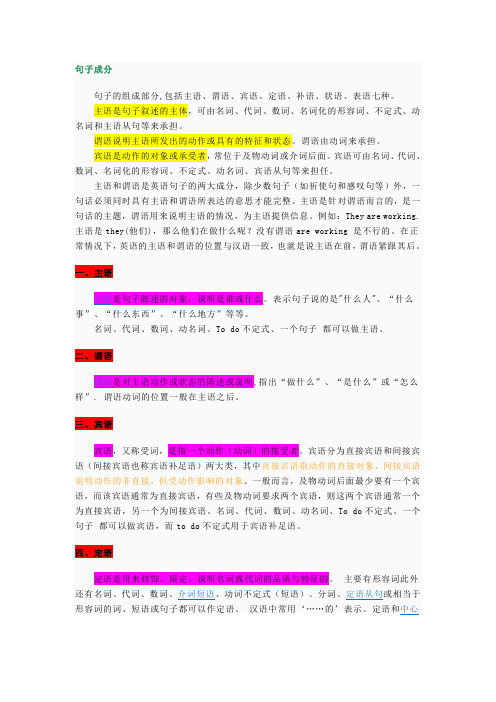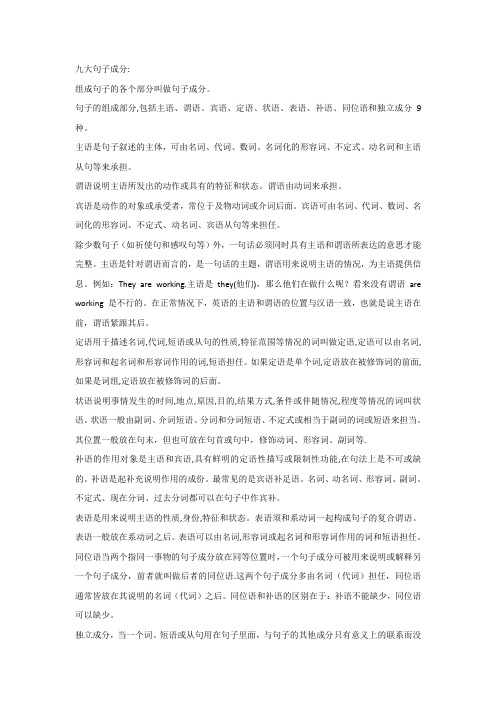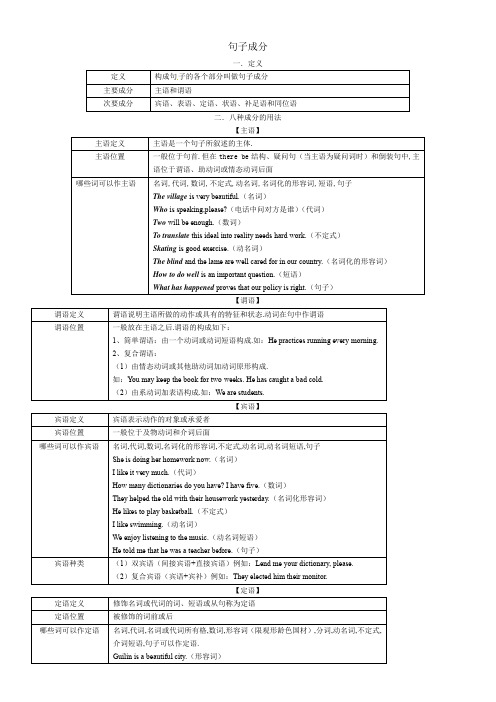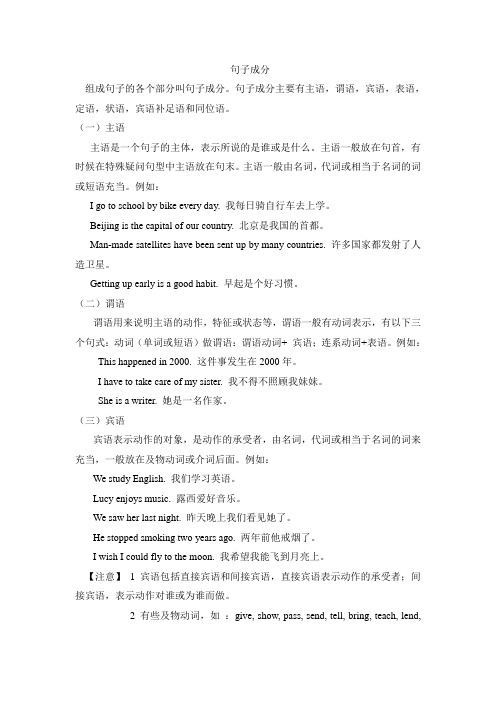句子成分
句子成分——精选推荐

句⼦成分句⼦成分 在平⽇的学习、⼯作和⽣活⾥,⼤家都听说过或者使⽤过⼀些⽐较经典的句⼦吧,从表达的⾓度说,句⼦是最基本的表述单位。
你所见过的句⼦是什么样的呢?以下是⼩编帮⼤家整理的句⼦成分,欢迎⼤家分享。
句⼦成分1 ⼀、句⼦成分 句⼦成分分为六种:主谓宾定状补 主语:说明是谁或什么 谓语:说明主语是什么或怎么样 宾语:是谓语的⽀配成分。
举个最简单的例⼦:我喝⽔。
“我”是主语,“喝”是谓语,“⽔”是宾语。
定语:是修饰句⼦中名词中⼼语的,在名词中⼼语前⾯。
状语:是修饰句⼦中动词或形容词的,在动词或形容词前⾯。
补语:是补充说明谓语的,在动词或形容词后⾯。
举个简单的例⼦,7班的同学正在上张⽼师的语⽂课,同学们听得很认真。
“7班的”“张⽼师的”就是定语。
“正在”就是状语。
“很认真”就是补语。
此外,划分句⼦成分还有两个万能公式: 公式⼀:【状语】,(定语)主语‖【状语】谓语中⼼词+(定语)宾语中⼼语 公式⼆:【状语】,(定语)主语‖【状语】谓语中⼼词+(定语)宾语中⼼语+〈补语〉 掌握以上⼏点,我相信同学们再遇到句⼦成分之类的判断题,就会迎刃⽽解了。
⼆、短语结构类型 短语结构类型分为五种:并列、偏正、动宾、后补、主谓短语。
并列短语:词与词之间是并列关系。
主要类型有名+名,动+动,形+形。
词与词中间常⽤“和、及、⼜、与、并“等连词。
偏正短语:前词为偏,起修饰作⽤。
后词为正,是词组的重⼼。
动宾短语:格式为动词+动词⽀配的对象。
动词⽀配的对象为宾语。
后补短语:格式为动词或形容词+起补充作⽤的成分。
起补充作⽤的成分是补语。
常有“得“作为标志。
主谓短语:格式为主语+谓语。
即“谁或什么”+“是什么或怎么了”。
掌握以上⼏点,判断短语结构类型也不是什么太困难的事。
句⼦成分2 1、他⾮常诚恳的征求⼤家的意见。
2、秋天⽐春天更富有欣欣向荣的景象。
3、张思德同志永远是我们学习的榜样。
4、汽车在望不到边际的⾼原上奔驰。
八种句子成分

句子成分一.定义定义构成句子的各个部分叫做句子成分主要成分主语和谓语次要成分宾语、表语、定语、状语、补足语和同位语二.八种成分的用法【主语】主语定义主语是一个句子所叙述的主体.主语位置一般位于句首.但在there be结构、疑问句(当主语为疑问词时)和倒装句中,主语位于谓语、助动词或情态动词后面哪些词可以作主语名词,代词,数词,不定式,动名词,名词化的形容词,短语,句子The village is very beautiful.(名词)Who is speaking,please?(电话中问对方是谁)(代词)Two will be enough.(数词)To translate this ideal into reality needs hard work.(不定式)Skating is good exercise.(动名词)The blind and the lame are well cared for in our country.(名词化的形容词)How to do well is an important question.(短语)What has happened proves that our policy is right.(句子)【谓语】谓语定义谓语说明主语所做的动作或具有的特征和状态.动词在句中作谓语谓语位置一般放在主语之后.谓语的构成如下:1、简单谓语:由一个动词或动词短语构成.如:He practices running every morning.2、复合谓语:(1)由情态动词或其他助动词加动词原形构成.如:You may keep the book for two weeks. He has caught a bad cold.(2)由系动词加表语构成.如:We are students.【宾语】宾语定义宾语表示动作的对象或承爱者宾语位置一般位于及物动词和介词后面哪些词可以作宾语名词,代词,数词,名词化的形容词,不定式,动名词,动名词短语,句子She is doing her homework now.(名词)I like it very much.(代词)How many dictionaries do you have? I have five.(数词)They helped the old with their housework yesterday.(名词化形容词)【定语】【状语】I shall go there if it doesn’t rain.(条件状语)Mr Smith lives on the third floor.(地点状语)She put the eggs into the basket with great care.(方式状语)She came in with a dictionary in her hand.(伴随状语)In order to ca tch up with the others, I must work harder.(目的状语)He was so tired that he fell asleep immediately.(结果状语)She works very hard though she is old.(让步状语)I am taller than he is.(比较状语)【宾语补足语】宾语补足语定义英语中有些及物动词,除有一个直接宾语以外,还要有一个宾语补语,才能使句子的意义完整.这种宾语补语就是宾语补足语.宾语补足语位置带有宾语补足语的一般句型为:某些及物动词(如make等+宾语+宾补)哪些词可以作宾语宾补可由名词、形容词、副词、不定式、分词、介词短语和句子充当His father named him Dongming.(名词)They painted their boat white.(形容词)Let the fresh air in.(副词)You mustn’t force him to lend his money to you.(不定式)We saw her entering the room.(现在分词)I had my bike repaired yesterday.(过去分词)We found everything in the lab in good order.(介词短语)We will soon make our city what your city is now.(句子)【表语】表语定义表语用以说明主语的身份、特征和状态表语位置它一般位于系动词(如be, become, get, look, grow, turn, seem等)之后.哪些词可以作表语表语一般由名词、代词、形容词、分词、数词、不定式、动名词、介词短语、副词及句子表示Our teacher of English is an American.(名词)Is it yours?(代词)The weather has turned cold.(形容词)The speech is exciting.(分词)Three times seven is twenty one?(数词)His job is to teach English.(不定式)His hobby(爱好)is playing football.(动名词)The machine must be out of order.(介词短语)Time is up. The class is over.(副词)The truth is that he has never been abroad.(表语从句)【同位语】定义一个名词(其它形式)对另一个名词或代词进行解释或补充说明,这个词(或其它形式)就是同位语位置同位语与被它限定的词的格式要一致,并常常紧挨在一起充当同位语的词名词,动名词,不定式,形容词,名词短语,动名词短语,不定式短语,介词短语,形容词短语直接引语,句子Mr wang,my child’s teacher,will be visiting us on Tuesday.(名词)I,the oldest girl in the family,always had to care for the other children.(名词短语)He enjoys the exercise,swimming in winter.(动名词)Asking him to join us,that’s a good ides.(动名词短语)Their aspiration,to become free and independent,is deserving of every kind of help from us.(不定式)The question what to do next hasn’t been considered.(不定式短语)As the head of the company,he had to explain what had happened.(介词短语)He,short and thin,is unfit for the job.(形容词)All the countries,big or small,are equal.(形容词短语)But now the question comes to their minds,“Did she die young because she was a clone?”(直接引语)The girl were surprised at the fact that ocean ships can sail up the Great lakes.(句子)【大展身手】1. ____ will leave for Beijin g.A. Now there the manB. The man here nowC. The man who is here nowD. The man is here now2. The weather ____.A. wet and cold B. is wet and co ldC. not wet and cold D. were wet and cold3. The apple tasted ____.A. sweets B. sweetly C. nicely D. sweet4. He got up ____ yesterday morning.A. lately B. late C. latest D. latter5. The actor ______at the age of 70.A. dead B. died C. dyed D. deaded6. ____ were all very tired, but none of ____ would stop to take a rest.A. We, usB. Us, weC. We, ourD. We, we7. He found the street much ______.A. crowd B. crowding C. crowded D. crowdedly8.I think _____necessary to learn English well.A. its B. i t C. that D. that is9. The dog ____ mad.A. looks B. is looked C. is being looked D. was looked10.I will never forget the day ______I joined the army.A. that B. when C. in which D. Where Keys:1-5 CBDBB 6-10 ACBAB。
什么是句子成分

什么是句子成分
句子成分是指句子的组成成分,它们按照一定的结构规律构成了句子。
常见的句子成分包括主语、谓语、宾语、定语、状语、补语等。
1. 主语:主语是句子的主要成分,通常位于句首,表示句子要陈述的对象或行为主体。
2. 谓语:谓语是对主语进行陈述或描述的部分,通常位于主语之后,表示主语的状态或行为。
3. 宾语:宾语是句子中的受事者,即主语行为或动作的对象,通常位于谓语之后。
4. 定语:定语是修饰名词或代词的成分,通常位于被修饰词之前,用于限定或描述该词的范围或属性。
5. 状语:状语是修饰动词、形容词或整个句子的成分,通常位于被修饰词之前,用于描述该词的时间、地点、方式等属性。
6. 补语:补语是对动词、形容词等词进行补充说明的成分,通常位于被修饰词之后,用于补充描述该词的程度、结果等属性。
以上是常见的句子成分及其作用,不同的句子成分在句子中有着不同的作用和位置,共同构成了句子的完整意义。
句子成分

句子成分句子的组成部分,包括主语、谓语、宾语、定语、补语、状语、表语七种。
主语是句子叙述的主体,可由名词、代词、数词、名词化的形容词、不定式、动名词和主语从句等来承担。
谓语说明主语所发出的动作或具有的特征和状态。
谓语由动词来承担。
宾语是动作的对象或承受者,常位于及物动词或介词后面。
宾语可由名词、代词、数词、名词化的形容词、不定式、动名词、宾语从句等来担任。
主语和谓语是英语句子的两大成分,除少数句子(如祈使句和感叹句等)外,一句话必须同时具有主语和谓语所表达的意思才能完整。
主语是针对谓语而言的,是一句话的主题,谓语用来说明主语的情况,为主语提供信息。
例如:They are working.主语是they(他们),那么他们在做什么呢?没有谓语are working 是不行的。
在正常情况下,英语的主语和谓语的位置与汉语一致,也就是说主语在前,谓语紧跟其后。
一、主语主语是句子陈述的对象,说明是谁或什么。
表示句子说的是"什么人"、“什么事”、“什么东西”、“什么地方”等等。
名词、代词、数词、动名词、To do不定式、一个句子都可以做主语。
二、谓语谓语是对主语动作或状态的陈述或说明,指出“做什么”、“是什么”或“怎么样”. 谓语动词的位置一般在主语之后。
三、宾语宾语,又称受词,是指一个动作(动词)的接受者。
宾语分为直接宾语和间接宾语(间接宾语也称宾语补足语)两大类,其中直接宾语指动作的直接对象,间接宾语说明动作的非直接,但受动作影响的对象。
一般而言,及物动词后面最少要有一个宾语,而该宾语通常为直接宾语,有些及物动词要求两个宾语,则这两个宾语通常一个为直接宾语,另一个为间接宾语。
名词、代词、数词、动名词、To do不定式、一个句子都可以做宾语,而to do不定式用于宾语补足语。
四、定语定语是用来修饰、限定、说明名词或代词的品质与特征的。
主要有形容词此外还有名词、代词、数词、介词短语、动词不定式(短语)、分词、定语从句或相当于形容词的词、短语或句子都可以作定语。
九大句子成分

九大句子成分:组成句子的各个部分叫做句子成分。
句子的组成部分,包括主语、谓语、宾语、定语、状语、表语、补语、同位语和独立成分9种。
主语是句子叙述的主体,可由名词、代词、数词、名词化的形容词、不定式、动名词和主语从句等来承担。
谓语说明主语所发出的动作或具有的特征和状态。
谓语由动词来承担。
宾语是动作的对象或承受者,常位于及物动词或介词后面。
宾语可由名词、代词、数词、名词化的形容词、不定式、动名词、宾语从句等来担任。
除少数句子(如祈使句和感叹句等)外,一句话必须同时具有主语和谓语所表达的意思才能完整。
主语是针对谓语而言的,是一句话的主题,谓语用来说明主语的情况,为主语提供信息。
例如:They are working.主语是they(他们),那么他们在做什么呢?看来没有谓语are working 是不行的。
在正常情况下,英语的主语和谓语的位置与汉语一致,也就是说主语在前,谓语紧跟其后。
定语用于描述名词,代词,短语或从句的性质,特征范围等情况的词叫做定语,定语可以由名词,形容词和起名词和形容词作用的词,短语担任。
如果定语是单个词,定语放在被修饰词的前面,如果是词组,定语放在被修饰词的后面。
状语说明事情发生的时间,地点,原因,目的,结果方式,条件或伴随情况,程度等情况的词叫状语。
状语一般由副词、介词短语、分词和分词短语、不定式或相当于副词的词或短语来担当。
其位置一般放在句末,但也可放在句首或句中,修饰动词、形容词、副词等.补语的作用对象是主语和宾语,具有鲜明的定语性描写或限制性功能,在句法上是不可或缺的。
补语是起补充说明作用的成份。
最常见的是宾语补足语。
名词、动名词、形容词、副词、不定式、现在分词、过去分词都可以在句子中作宾补。
表语是用来说明主语的性质,身份,特征和状态。
表语须和系动词一起构成句子的复合谓语。
表语一般放在系动词之后。
表语可以由名词,形容词或起名词和形容词作用的词和短语担任。
同位语当两个指同一事物的句子成分放在同等位置时,一个句子成分可被用来说明或解释另一个句子成分,前者就叫做后者的同位语.这两个句子成分多由名词(代词)担任,同位语通常皆放在其说明的名词(代词)之后。
句子成分

4)方式状语 ) She put the eggs in to the basket with great care. He has greatly improved his spoken English by this means. 5)目的状语 ) In order to catch up with the others, I must work harder. Bring it closer so that I may see it better. 6)结果状语 ) He was so tired that he fell asleep immediately(马上 马上). 马上 He is so good a teacher that the students love him. 7)比较状语 ) I am taller thБайду номын сангаасn he is. 8)让步状语 ) Childe as he is , he can take care of himself.
2.谓语 谓语 谓语和主语一样,是一个句子的主干部分之一, 谓语和主语一样,是一个句子的主干部分之一,表 示主语所做的动作,具有的特征及所处的状态, 示主语所做的动作,具有的特征及所处的状态,通常由动 词充当,动词常分为实义动词,连系动词, 词充当,动词常分为实义动词,连系动词,情态动词以及 助动词.情态动词和助动词不能单独充当谓语, 助动词.情态动词和助动词不能单独充当谓语,它们必须 和实义动词或连系动词一起构成谓语. 和实义动词或连系动词一起构成谓语.实义动词包括及物 动词和不及物动词, 及物动词后面要带宾语. 动词和不及物动词, 及物动词后面要带宾语.通常情况 下, 谓语位于主语之后. 谓语位于主语之后. 例如: 例如: They work very hard. (不及物动词) 不及物动词) 及物动词) She bought a new house last year. (及物动词) We can speak English very well.(情态动词 实义动词) 实义动词) (情态动词+实义动词 (连系动词 实义动词) They are playing over there.(连系动词+实义动词) 实义动词 He doesn't like fishing. (助动词 实义动词) 助动词+实义动词 实义动词)
句子成分(汉语)

表示删除
表示删改
表示增加内容 表示左右词语互换位置
表示左右词语互换位置, 表示左右词语互换位置, 中间的词语或标点不动
修改病句的原则
努力保持原句的意思不变 努力做最小的改动,能改动一个字,不改动一个词。 努力做最小的改动,能改动一个字,不改动一个词。 尽量不要重抄,就在原文上改,改正越明显越好。 尽量不要重抄,就在原文上改,改正越明显越好。 用简洁规范的语言指出句子的病因。 用简洁规范的语言指出句子的病因。
3.宾语有多余成分
中国队获得参加决赛阶段的资格。 中国队获得参加决赛阶段的资格。
也可以删 去“青年”
4.定语多余
参加会议的既有老一代革命家,也有年轻的青年干 参加会议的既有老一代革命家, 部。
5.状语多余 •6.补语多余
也可以删 去“很快”
目前财政困难,有些问题短期内不可能很快解决。 目前财政困难,有些问题短期内不可能很快解决。
句子成分: 谓语、宾语、 句子成分:主语、谓语、宾语、 定语、状语、 定语、状语、补语
例句:学生听报告。 例句:学生听报告。 学生在多媒体教室听报告。 学生在多媒体教室听报告。 学生在多媒体教室听报告。 学生在多媒体教室听报告。 (三九班) 报告。 学生在多媒体教室听<完>报告。 (三九班)
修改病句 一、什么是病句
凡是违反客观事理或语言结构规律的句子都是病句 人们通常把违反客观事理的情况叫逻辑错误, 人们通常把违反客观事理的情况叫逻辑错误,把违反语 言结构规律的情况叫语法错误。 言结构规律的情况叫语法错误。 1.搭配不当 1.搭配不当 2.残缺和多余 残缺和多余 3.语序不当 语序不当 4.句式杂糅 句式杂糅 5.歧义 歧义
在语文数学这两门课中, 在语文数学这两门课中,数学对我最感兴 趣。
句子成分有六种

2、谓语 、 是对主语的叙述、描写或判断,能回答主语“ 是对主语的叙述、描写或判断,能回答主语“怎么 是什么”等问题。 样”或“是什么”等问题。
• • • • • • •
(1)动词性词语经常做谓语。例如: )动词性词语经常做谓语。例如: 答应了<一声 他‖[只]答应了 一声 。 只 答应了 一声>。 谓语(状语+动词 补语) 动词+补语 主语 谓语(状语 动词 补语) 南海一中‖留下<过 许多人 的梦。 许多人)的梦 南海一中‖留下 过>(许多人 的梦。 主语谓语(动词+补语 定语+宾语 补语+定语 宾语) 主语谓语(动词 补语 定语 宾语) 最近]去 了 一趟 北京。 一趟>北京 我‖[最近 去<了><一趟 北京。 最近 谓语( 主语 谓语(状+动+补+宾) 动 补 宾
(2)形容词性词语也经常做谓语。 )形容词性词语也经常做谓语。
• • • • • • • 例如: 例如: 太阳‖热烘烘的。 太阳‖热烘烘的。 主语谓语(形容词+的 主语谓语(形容词 的) 人参这种植物,‖娇嫩<极了 极了>。 人参这种植物 ‖娇嫩 极了 。 谓语(形容词+补语 补语) 主语 谓语(形容词 补语) 说话‖ 要 简洁 简洁<些 。 说话‖[要]简洁 些>。 谓语(状语+形容词 补语) 形容词+补语 主语 谓语(状语 形容词 补语)
• (7)可能补语:这种补语的中心语主要是 )可能补语: 动词,也有少数是形容词。补语有两种, 动词,也有少数是形容词。补语有两种, 一种是用“ 不得”充当, 一种是用“得”或“不得”充当,表示动 作结果能实现或不能实现, 作结果能实现或不能实现,另一种是在结 果补语或趋向补语和中心与之间插进“ 果补语或趋向补语和中心与之间插进“得/ 不”,表示动作的结果、趋向可能不可能 表示动作的结果、 实现。例如: 实现。例如: • 这个东西吃〈得〉吃〈不得〉? 作业一定 这个东西吃〈 不得〉 要认真做,马虎〈不得〉 看得清楚, 要认真做,马虎〈不得〉。 看得清楚,看 <不>清楚? 清楚? 不 清楚
句子成分有六种

句子成分有六种——主语、谓语、宾语、定语、状语、补语。
基本成分主谓宾,附加成分定状补:
定语必居主宾前, 谓前为状谓后补.
宾语只受谓支配,的定地状得后补。
标点符号歌诀:
逗冒顿分用句中,句叹问号句末停;并列词语用顿号,并列分句才用分;
确数定要用顿号,概数之间不用顿;选择问,倒装问,全句末尾才用问;
某某说,要注意,前冒中逗后用句:引用之语能独立,末尾点号引号里;
点号放在引号外,引用之语不独立;转折解释破折号,表示注释加括号;
标点符号很重要,牢记规则别忘掉。
唐宋八大家:韩柳三苏欧阳修,安石曾巩八大家。
名著歌诀:
东西三水桃花红,官场儒林爱金瓶;
三言二拍赞古今,聊斋史书西厢镜。
(《东周列国志》、《西游记》、《三国演义》、《水浒传》、《桃花扇》、《红楼梦》;《官场现形记》、《儒林外史》、《金瓶梅》、《警世通言》、《喻世明言》、《醒世恒言》、《初刻拍案惊奇》、《二刻拍案惊奇》、《古今奇观》;《聊斋志异》、《史记》、《西厢记》、《镜花缘》)。
句子成分及类型

句子成分及类型:一、句子的成分:句子的组成部分分为:主语、谓语、宾语、定语、状语、表语,其中主语与谓语是主要成分,一般不可缺少;其它成分可根据具体的句子加以选择。
1.主语:句子的主体,表示句子所说的是谁或是什么,一般由名词、代词,或者相当于名词的词、短语或从句充当(包括不定式、动名词还有名词性从句),如, The students are all very clever.It is a wonderful film.Studying English is very important.To teach him a lesson seems quite necessary.That he won the prize excited everyone.2.谓语:说明主语的动作、状态或特征;由动词充当,如,They all work hard to make their homeland more beautiful.I like football very much.3.宾语:表示动作的对象,跟主语的性质差不多,一般由名词、代词,或者相当于名词的词、短语或从句充当(包括不定式、动名词还有名词性从句),4.表语:说明主语的性质、特征、身份等,一般由名词(或相当于名词的词、短语或句子)、形容词、介词短语等充当,如, The story is very interesting.Her uncle is a teacher.My wallet is on the desk.My suggestion is that we should start at once.My suggestion is to leave at once.5.定语:用来修饰名词或代词,起限定作用;通常由形容词、代词、数词、名词、介词短语、从句等来表示,如,The wallet on the desk is mine.In the picture there is an apple tree.He is one of the students that have been late.6.状语:用来修饰动词、形容词或者副词,一般表示行为发生的时间、地点、目的、方式、程度等意义,通常由副词、介词短语、从句等来表示,如,We will have the meeting in the big hall.Why not go with us since you have enough time?*补语:以上的都是句子的组成部分,而补语则是从句子的从含义上说而引申出的一个概念,是对原来意义的一种补充,表语、状语、同位语等有时都可以看作是一种补语,如,He is right over there, watering the flowers.Nobody can change my mind, including my parents.二、句子的分类:. 交际功能上:陈述句、疑问句、祈使句、感叹句1.陈述句;用来说明事实或者说话人看法;2.疑问句:A.一般疑问句:对某一情况是否事实提出疑问,一般用YES,或NO来回答,有两种形式:be/have+主语…..?助动词(情态动词)+主语+行为动词……?B.特殊疑问句:用疑问词(what, who, how, why, when,where…)提问,一般有两种结构,疑问词+一般疑问句型结构,what are you doing?疑问词做主语或主语的定语时用陈述语序,what is your name?C.反意疑问句:表示提问者有一定的主观看法,但没有把握,希望对方来证实;有四种形式:前肯定后否定、前否定后肯定、前后都肯定、前后都否定,较为常用的为两种:前肯定后否定、前否定后肯定。
现代汉语句子成分划分

现代汉语句子成分划分现代汉语句子成分划分现代汉语句子成分划分怎么样划分,现代汉语句子成分划分是怎么样的呢?以下就是店铺整理的现代汉语句子成分划分,一起来看看吧!一、句子成分的构成:句子有六个成分:主语、谓语、宾语、补语、定语、状语。
主语和谓语:主语是句子里被陈述的对象,谓语是用来陈述主语的。
在一般情况下,主语在前,谓语在后。
(1)大伙都散了。
(《分马》)(2)满树浅黄色的小花,并不出众。
(《荔枝蜜》)(3)我最不能忘记的是他的背影。
(《背影》)(4)利用物候知识来研究农业生产,已经发展为一门科学。
(《大自然的语言》)(5)那壮丽的柱廊,淡雅的色调,以及四周层次繁多的建筑立面,组成了一幅庄严绚丽的画图。
(《雄伟的人民大会堂》)这几句的主语是"大伙" "满树浅黄色的小花"" 我最不能忘记的"" 利用物候知识来研究农业生产"" 那壮丽的柱廊,淡雅的色调,以及四周层次繁多的建筑立面",这几句的谓语是"都散了"" 并不出众"" 是他的背?" 已经发展为一门科学"" 组成了一幅庄严绚丽的画图"。
把中心词看成是主语和谓语也是可以的。
如:(6)一张简陋的大竹床铺着厚厚的稻草。
(《驿路梨花》)(7)其实这种缩微技术,早在十九世纪普法战争时候就使用过了。
(《从甲骨文到缩微图书馆》)可以认为"竹床""技术"是主语,可以认为"铺""使用"是谓语。
宾语和补语:宾语往往表示动作支配的对象,并且总是处在动词的后头。
补语是动词形容词后面的补充成分。
如:(1)桥脚上站在一个人,却是我们母亲。
(鲁迅《社戏》)(2)我最不能忘记的是他的背影。
(《背影》)(3)萧队长说过:先进的要带落后的。
什么叫句子成分

什么叫句子成分呢?句子的组成成分叫句子成分。
在句子中,词与词之间有一定的组合关系,按照不同的关系,可以把句子分为不同的组成成分。
句子成分由词或词组充当。
现代汉语里一般的句子成分有六种,即主语、谓语、宾语、定语、状语和补语。
英语的基本成分有七种:主语(subject)、谓语(predicate)、表语(predicative)、宾语(object)、定语(attribute)、状语(adverbial) 和补语(complement)。
英语句子的基本结构可以归纳成五种基本句型及其扩大、组合、省略或倒装。
掌握这五种基本句型,是掌握各种英语句子结构的基础。
英语五种基本句型列式如下:一:SV(主+谓)二:SVP(主+系+表)三:SVO(主+谓+宾)四:SVoO(主+谓+间宾+直宾)五:SVOC(主+谓+宾+宾补)基本句型一:SV(主+谓)主语:可以作主语的成分有名词(如boy),主格代词(如you),动词不定式,动名词等。
主语一般在句首。
注意名词单数形式常和冠词不分家!谓语:谓语由动词构成,是英语时态、语态变化的主角,一般在主语之后。
不及物动词(vi.)没有宾语,形成主谓结构,如:We come.此句型的句子有一个共同特点,即句子的谓语动词都能表达完整的意思。
这类动词叫做不及物动词,后面可以跟副词、介词短语、状语从句等。
S│ V(不及物动词)1. The sun │was shining. 太阳在照耀着。
2. The moon │rose. 月亮升起了。
3. The universe │remains. 宇宙长存。
4. We all │breathe, eat, and drink. 我们大家都呼吸、吃和喝。
5. Who │cares? 管它呢?6. What he said │does not matter. 他所讲的没有什么关系。
7. They │talked for half an hour. 他们谈了半个小时。
句子成分

复合谓语也可分为两种情况: 第一种是由情态动词,助动词+不带to的动词不定式构 成的复合谓语: What does this word mean? I won’t do it again. I’ll go and move away the bag of rice with Lin Tao. You’d better catch a bus. 第二种是由连系动词+表语构成的复合谓语。例如: You look the same. We are all here. The weather gets wamer, and the days get longer. Keep quiet and listen to me. He looked worried.
5,it作主语,有如下情况: 1)指代刚刚提到的事物:What’s this ? It’s a bus. (指 代what) 2)指代一个你不知道或判断不清性别的人:Who’s knocking the door? It’s me. (指代 who) Who’s the baby in the picture? It’s my sister. 3) 表示时间,天气,距离: What’s the time? It’s eight o’clock. What’s it going to be tomorrow? It’s going to be fine. How far is it? It’s about one kilometre away. (距离) 6. THERE 引起的There be 句型中,be 作谓语,主语 位居其后。如: There are many different kinds of mooncakes. There will be a strong wind.
八种句子成分

The villageis very beautiful.(名词)
Whois speaking,please?(电话中问对方是谁)(代词)
Twowill be enough.(数词)
To translatethis ideal into reality needs hard work.(不定式)
His job is to teach English.(不定式)
His hobby(爱好)is playing football.(动名词)
The machine must be out of order.(介词短语)
Time is up. The class is over.(副词)
The truth is that he has never been abroad.(表语从句)
Our monitor is always the first to enter the classroom.(不定式短语)
The teaching plan for next term has been worked out.(动名词)
He is reading an article about how to learn English.(介词短语)
【定语】
定语定义
修饰名词或代词的词、短语或从句称为定语
定语位置
被修饰的词前或后
哪些词可以作定语
名词,代词,名词或代词所有格,数词,形容词(限观形龄色国材),分词,动名词,不定式,介词短语,句子可以作定语.
Guilin is a beautiful city.(形容词)
China is a developing country; America is a developed country.(分词)
句子成分

1、简单谓语:由一个动词或动词短语
构成。如: He practices running every morning. The plane took off at ten o’clock.
2、复合谓语: (1)由情态动词加动词原形构成。如:
You may keep the book for two weeks. (2)由助动词加动词原形,现在分词,过去分词构 成。如: Do you speak English? They are working in a field. He has caught a bad cold. (3)由系动词加表语构成。如: We are students. 注意:谓语与主语在人称与数方面要保持一致。
句子成分
一、句子成分
(一)句子成分的定义: 构成句子的各个部分叫做句子
成分。
句子成分有主要成分和次要成分;
主要成分有主语和谓语;
次要成分有表语、宾语、定语、
状语、补足语、同位语和插入语。
二、 主语
主语
(Subject)
是句子要说明的人或事物,是句子 的主体,一般由名词、代词、数词、 不定式或动名词等充当。
They
4.They helped the old with their housework yesterday. (名词化形容词,名词) She wants to go home。
(不ing to music.
(动名词短语)
7.I think(that)he is fit for his office.
1. They are workers.(名词) 2.Is it yours? (代词) 3. The story is very interesting.(形容词) 4.The speech is exciting.(分词) 5. Two and three is five.(数词)
句子成分

句子成分句子是有不同的各部分组成的,这些部分就叫做句子成分。
句子成分可以是单词、词组或句子(从句)。
在句中起主要作用的是主语、谓语,称为主要成分;起次要作用的有宾语、宾语补足语、定语、状语和表语,称为次要成分。
所有的句子都是在简单句的基础上展开的,所以我们首先讨论简单句的五种基本句型。
一、简单句的五种基本句型(Five kinds of simple sentences)(一)主语+ 不及物动词(主、谓结构)eg. 1)He is working.2)He cooks.(二)主语+ 及物动词+ 宾语(主、谓、宾结构)eg. 1)We study English every day.2)They are playing football(三)主语+ 连系动词+ 表语(主、系、表结构)eg. 1)Trees turn green.2)He is happy.常见的连系动词有:be ; become ; get(“天气”变得); turn(“颜色”变得); feel(觉得/摸起来); look(看起来);smell(闻起来); sound(听起来);taste(尝起来);seem(似乎).特别注意:a) 连系动词后常接形容词常作表语;b) be / become后常接名词或相当于名词的短语(不定式/动名词)做表语。
c) seem + 形容词= seem to be + 形容词eg.1)He is a teacher (名词做表语)2)His job is to feed animals (不定式做表语)3)His hobby is reading. (动名词做表语)4)He seems happy = He seems to be happy(四)主语+ 及物动词+ 间宾(人)+ 直宾(物)=主语+ 及物动词+ 直宾(物)+ to / for + 间宾(人)常用的此类动词有:give ; pass ; show ; lend ; buy. 但buy与for连用eg.1)I gave him a book.= I gave a book to him.2) My mother bought me a pen yesterday.= My mother bought a pen for me.(五)主语+ 及物动词+ 宾语+ 宾补注意作宾补的词:1)名词(指宾语是谁/什么);2)形容词;3)不定式;4)动词的ing 形式。
句子成分

II、句子类型(按句子结构分)
简单句、并列句、复合句、
并列复合句
1、简单句 只包含一个主谓结构,个个 成分都是单词或短语的句子。
All roads lead to Rome. Don’t be shy. Have a try.
2、并列句 包含两个或两个以上的独立的主 谓结构或简单句的句子,叫并列 句。这些分句,在形式上处于平 等的,互不依存的并列地位,但 是这些独立的句子往往在意义上
句 子 成 分
(二)谓语 谓语说明主语的动作、行为或所 处的状态。通常由动词的各种形式来 充当。并且和主语在人称和数上保持 一致。谓语有广义与狭义之分,广义 的谓语指主语以外包括动词在内的部 分,狭义的谓语仅仅指动词,这里我 们讨论的是广义上的谓语。
句 子 成 分
1.一般谓语都是由一个动词或动词 短语来充当 She got here at six.
What a good time we had last night! How foolish she is!
5、 There-be存在句
There is certain to be a heavy rain tonight. There seems to be some misunderstanding. There is a baby crying in the next door.
3、复合句 复合句由一个主句和 一个或一个以上的从句构 成。主句和从句都具有完 整的主谓结构,但主句是全句 的主体,从句只是全句中的一 个成分,不能独立存在。从句 通常是用引导词来引导的。在 这里引导词还起联系从句和主 句的作用。
(1)名词性从句 主语从句、宾语从句、表 语从句和同位语从句统称为名 词性从句。 宾语从句注意事项:引导词、 语序、时态呼应、语态。 主语/表语/同位从句注意事项: 引导词、语序、语态。
句子成分

句子成分组成句子的各个部分叫句子成分。
句子成分主要有主语,谓语,宾语,表语,定语,状语,宾语补足语和同位语。
(一)主语主语是一个句子的主体,表示所说的是谁或是什么。
主语一般放在句首,有时候在特殊疑问句型中主语放在句末。
主语一般由名词,代词或相当于名词的词或短语充当。
例如:I go to school by bike every day. 我每日骑自行车去上学。
Beijing is the capital of our country. 北京是我国的首都。
Man-made satellites have been sent up by many countries. 许多国家都发射了人造卫星。
Getting up early is a good habit. 早起是个好习惯。
(二)谓语谓语用来说明主语的动作,特征或状态等,谓语一般有动词表示,有以下三个句式:动词(单词或短语)做谓语:谓语动词+ 宾语;连系动词+表语。
例如:This happened in 2000. 这件事发生在2000年。
I have to take care of my sister. 我不得不照顾我妹妹。
She is a writer. 她是一名作家。
(三)宾语宾语表示动作的对象,是动作的承受者,由名词,代词或相当于名词的词来充当,一般放在及物动词或介词后面。
例如:We study English. 我们学习英语。
Lucy enjoys music. 露西爱好音乐。
We saw her last night. 昨天晚上我们看见她了。
He stopped smoking two years ago. 两年前他戒烟了。
I wish I could fly to the moon. 我希望我能飞到月亮上。
【注意】1 宾语包括直接宾语和间接宾语,直接宾语表示动作的承受者;间接宾语,表示动作对谁或为谁而做。
2 有些及物动词,如:give, show, pass, send, tell, bring, teach, lend,buy, make,etc..可以接两个宾语,即上述指人的间接宾语和指物的直接宾语。
- 1、下载文档前请自行甄别文档内容的完整性,平台不提供额外的编辑、内容补充、找答案等附加服务。
- 2、"仅部分预览"的文档,不可在线预览部分如存在完整性等问题,可反馈申请退款(可完整预览的文档不适用该条件!)。
- 3、如文档侵犯您的权益,请联系客服反馈,我们会尽快为您处理(人工客服工作时间:9:00-18:30)。
句子的成分句子成分包括:主语、谓语、表语、宾语(直接宾语、间接宾语)、补足语(主语补足语、宾语补足语)、定语和状语。
主语和谓语是句子主体部分(在英语中一般的句子必须有主语和谓语)主语:动作的执行者。
谓语:主语发出的动作。
宾语:动作涉及的对象。
表语:系动词后面的词一般就是表语。
定语:对修饰词进行限定。
补足语:对词进行补充。
状语:表示时间、地点、状态、原因、方式、结果等(如果删去,不影响句子完整)例如:We should keep the nice room clean today.主语:We谓语:should keep (是主语we发出的动作)宾语:the nice room (是谓语涉及的对象)定语:nice (修饰room)宾语补足语:clean (对nice room进行补充说明房子干净)状语:today (表示时间)主语(the subject)主语表示句子所说的是什么人或什么事。
To teach them English is my job.不定式作主语时,常用形式主语it句型,因此可变为:It is my job to teach them English.练习:找出下列句子的主语。
1、The boy comes from America.2、He usually goes to school alone.3、Studying English is very important.4、To teach him a lesson seems quite necessary.5、That he won the prize excited everyone.6、It is important for us to have our dreams.7、It is obvious that he was wrong.8、It is no use crying over spilt milk.归纳:主语一般由名词、____,或者相当于名词的词、短语或从句充当(包括____、____还有____)。
另外,当句子的主语为____、____或____时,主语部分太长,为使句子平衡,避免头重脚轻,常用it作形式主语,把真正的主语放在后面。
谓语(the predicate)说明主语的动作、状态或特征(即主语做什么,是什么或者怎么样)。
谓语(谓语部分里主要的词)必须用动词。
一般情况下,它在主语后面。
(谓语与主语在人称与数方面要保持一致)补充:动词分为实义V、系V、情态V和助V。
实义V可单独作谓语,系V与表语一起构成谓语,说明主语的状态、性质、特征或身份。
情态V与动词原形构成合成谓语,助V与动词的适当形式(如:原形、现在分词、过去分词)共同构成谓语部分。
Eg:1) His parents are doctors.(系V表语一起作谓语)2) We have finished reading the book.(助V实义V起作谓语)3) He can speak English.(情态V实义V谓语)练习:找出下列句子的谓语并指出谓语的构成。
1、His parents are teachers.2、The sun rises in the east.3、You ought to work harder.4、I felt cold.5、He doesn’t like music.宾语(the object)宾语是动词的动作对象。
一般由n 、宾格pron(me,her等),或者相当于n的词,短语或从句充当(包括不定式、动名词还有宾语从句)。
它和及物V一起说明主语做了什么,在谓语之后。
顺序是“主语+谓语+宾语”宾语分为直接宾语和间接宾语,间接宾语说明动作是对谁或为谁而做,直接宾语则是动作的承受者或结果。
间接宾语指人,直接宾语指物。
Eg:I give him a gift.直接宾语:a gift间接宾语:him练习:找出下列句子的宾语。
1、He has never met her in person.2、She handed him a book.3、He likes to play basketball.4、We enjoy listening to music.5、She said that she felt sick.6、They sent the injured to hospital.7、I find it impossible to believe her any longer.8、We consider it no good getting up late.9、They believed it strange that he should have done that.归纳:当句子的宾语为___、____、或_____时,常用形式宾语it,以保持句子的平衡。
表语(the predicative)表语说明主语是“是什么”“怎么样”。
系V是表示人或事物状态、性质的V。
系V后面的部分叫表语。
作表语的典型词类是adj,也可以是n、数词、极少数adv(如here, there)、介词短语、不定式。
分词、表语从句等。
系V与表语共同构成谓语,说明主语的状态、性质等。
Eg:1)You look younger than before.2)I am a teacher.3)Everybody is here.4)They are at home now.5)My job is to teach them English.练习:找出下列句子的表语并指出表语是由什么来充当的。
1、My wallet is on the desk.2、The book isn’t mine.3、The leaves turn yellow in fall.4、He has become a police officer.5、My suggestion is that we should start at once.6、My suggestion is to leave at once.7、His speech was boring.8、The whole class got excited at the good news.拓展:系V(link verbs)英语中有相当多的系V,都可跟一个表语,与之构成符合谓语。
有3类:1、表示特征或状态的系V,如:be , feel , look , sound , taste , smell , seem , appear2、表示状态转变的系V,如:become , grow , get , turn , fall, go , come , run3、表示保持某种状态的系V,如:remain , continue , keep , stay , prove , turn outeg:1)She remained quite calm.她保持相当冷静。
2)The weather continued fine for several days. 好几天天气都很好。
助V助动词:be , do , have情态V:1、can / could2、may / might3、must / have to4、shall / should / ought to5、will / would6、used to7、be to8、be supposed to9、be about to 10、need 11、dare 12、had better定语(the attribute)定语用来修饰n或pron,起限定作用。
作定语的典型词是形容词和形容词性物主代词,也可以是数词、名词、介词短语、分词、定语从句等。
定语一般位于被修饰词之前,但若修饰复合不定代词(如something)时,或者是短语或定语从句作定语,则总是放在所修饰n的后面。
Eg:1)The black bike is mine. ( adj )2) What is your name? ( pron )3) They made paper flowers. ( n )4) The boys in the room are in Class Three, Grade One. ( 介词短语)5) I have something to do. (不定式)练习:找出下列句子的定语并指出定语是由什么充当(形容词、形容词性代词、数词、名词、介词短语、分词还是定语从句)1、The beautiful sight attracts many tourists every year.2、The wallet on the desk is mine.3、The demanding boss wasn’t satisfied with my work.4、That building being repaired is our library.5、He is one of the students that have been late.6、The excited boys burst into cheers.7、The woman police officer was praised for her good work.状语(the adverbial modifier)状语用来修饰V、adj 、adv或整个句子。
一般表示行为发生的时间、地点、目的、方式、程度等,作状语的典型词是adv,也可以是介词短语、不定式、分词、状语从句等。
Eg:1) He did it carefully.2) Without his help, we couldn’t work it out.3) (In order ) to catch up with my classmates, I must study hard.练习:找出下列句子的状语并指出状语是由什么充当(副词、介词短语、不定式、分词、状语从句)。
1、He did his homework carefully at home.2、Her mother goes out to do some shopping on Sunday.3、When I grow up, I am going to be a teacher.4、Feeling tired, he went to bed without supper.5、He lost his job due to his lack of patience.6、Brought out in the country, he finds it hard to adjust himself to city life.补足语(the complement)补充说明主语的称为主语补足语;补充说明宾语的称为宾语补足语。
